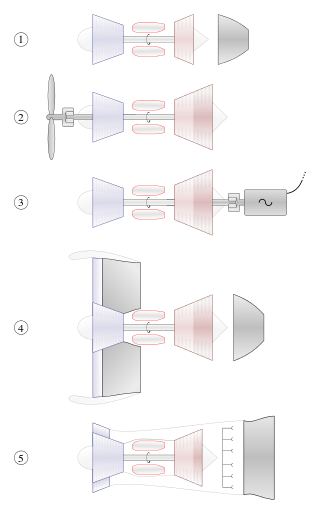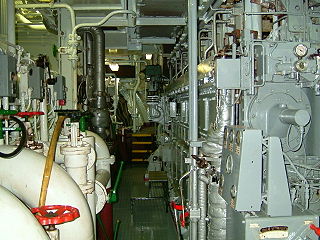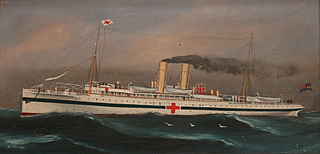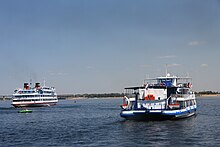
A gas turbine or gas turbine engine is a type of continuous flow internal combustion engine. The main parts common to all gas turbine engines form the power-producing part and are, in the direction of flow:

A steamship, often referred to as a steamer, is a type of steam-powered vessel, typically ocean-faring and seaworthy, that is propelled by one or more steam engines that typically move (turn) propellers or paddlewheels. The first steamships came into practical usage during the early 19th century; however, there were exceptions that came before. Steamships usually use the prefix designations of "PS" for paddle steamer or "SS" for screw steamer. As paddle steamers became less common, "SS" is incorrectly assumed by many to stand for "steamship". Ships powered by internal combustion engines use a prefix such as "MV" for motor vessel, so it is not correct to use "SS" for most modern vessels.

A steamboat is a boat that is propelled primarily by steam power, typically driving propellers or paddlewheels. The term steamboat is used to refer to small steam-powered vessels working on lakes, rivers, and in short-sea shipping. The development of the steamboat led to the larger steamship, which is a seaworthy and often ocean-going ship.

A paddle steamer is a steamship or steamboat powered by a steam engine driving paddle wheels to propel the craft through the water. In antiquity, paddle wheelers followed the development of poles, oars and sails, whereby the first uses were wheelers driven by animals or humans.

A diesel–electric transmission, or diesel–electric powertrain, is a transmission system powered by diesel engines for vehicles in road, rail, and marine transport. Diesel–electric transmission is similar to petrol–electric transmission, which is powered by petrol engines.

On a ship, the engine room (ER) is the compartment where the machinery for marine propulsion is located. The engine room is generally the largest physical compartment of the machinery space. It houses the vessel's prime mover, usually some variations of a heat engine. On some ships, there may be more than one engine room, such as forward and aft, or port or starboard engine rooms, or may be simply numbered. To increase a vessel's safety and chances of surviving damage, the machinery necessary for the ship's operation may be segregated into various spaces.

Selandia was the name of three ships of the Danish East Asiatic Company, the best known of which, the first MS Selandia of 1912, was the most advanced ocean-going diesel motor ship of her time.

Royal Mail Ship, usually seen in its abbreviated form RMS, is the ship prefix used for seagoing vessels that carry mail under contract to the British Royal Mail. The designation dates back to 1840. Any vessel designated as "RMS" has the right both to fly the pennant of the Royal Mail when sailing and to include the Royal Mail "crown" insignia with any identifying device and/or design for the ship.

A & J Inglis Limited, was a shipbuilding firm founded by Anthony Inglis and his brother John, engineers and shipbuilders in the Partick area of Glasgow, Scotland in 1862. The firm built over 500 ships in a period of just over 100 years. Their Pointhouse Shipyard was at the confluence of the rivers Clyde and Kelvin. They constructed a wide range of ships, including Clyde steamers, paddle steamers and small ocean liners. In wartime, they built small warships, and in the period after World War II, they built a number of whalers.

An oil burner engine is a steam engine that uses oil as its fuel. The term is usually applied to a locomotive or ship engine that burns oil to heat water, to produce the steam which drives the pistons, or turbines, from which the power is derived.

Marine propulsion is the mechanism or system used to generate thrust to move a watercraft through water. While paddles and sails are still used on some smaller boats, most modern ships are propelled by mechanical systems consisting of an electric motor or internal combustion engine driving a propeller, or less frequently, in pump-jets, an impeller. Marine engineering is the discipline concerned with the engineering design process of marine propulsion systems.

SS Clan Chisholm was a British cargo steamship. She was torpedoed and sunk in the Second World War while carrying cargo from India to Scotland.
MV Domala was a British cargo liner that was launched in 1920 as Magvana, but completed in 1921 as Domala. She was the first major ocean-going passenger ship to be built in the United Kingdom as a motor ship.

Brighton was a 1,384 GRT steamship which was built in 1903 for the London, Brighton and South Coast Railway and London and South Western Railway. She passed to the Southern Railway on 1 January 1923. In 1930, she was sold to W E Guinness and converted to a private yacht, Roussalka. She was wrecked at Killary Bay on 25 August 1933.In June 2024, members of the Athlone Sub Aqua Club rediscovered the remains of the wreck.It had been found in the 1970s but its position was lost. The Sub Aqua team is logging and filming the wreck for historical interest.
SS Binnendijk was a Holland America Line (NASM) cargo steamship. She was one of NASM's "B" class ships: the company's first cargo ships to be powered by steam turbines. Binnendijk was built in South Holland in 1921, and sunk by a mine in the English Channel in 1939. She was the first ship that NASM lost in the Second World War. Her wreck off the coast of Dorset, England is now a wreck diving site, nicknamed "The Benny".
SS Hertford was a refrigerated cargo steamship that was launched in Germany in 1917, seized by the United Kingdom in 1920 as World War I reparations, and sunk by a U-boat in 1942 with the loss of four members of her crew.

Steam-powered vessels include steamboats and steamships. Smaller steamboats were developed first. They were replaced by larger steamships which were often ocean-going. Steamships required a change in propulsion technology from sail to paddlewheel to screw to steam turbines. The latter innovation changed the design of vessels to one that could move faster through the water. Engine propulsion changed to steam turbine in the early 20th century. In the latter part of the 20th century, these, in turn, were replaced by gas turbines.

SS Karsik was a German-built cargo steamship. Deutsche Schiff- und Maschinenbau (Deschimag) built her as Soneck for Deutsche Dampfschifffahrts-Gesellschaft "Hansa" in 1938.

SS Bärenfels was a German steam cargo liner that was launched in 1921 for DDG Hansa. In 1940, she took part in the German invasion of Norway and was sunk by Fleet Air Arm dive bombers. Her wreck was raised, and in 1941, she was returned to service. In 1944, a Royal Navy midget submarine sank her, killing 11 of her complement. In 1947, her wreck was raised to be scrapped, but while under tow she sank a third time. The wreck is now a recreational wreck diving site.
SS Algarve was a Danish cargo steamship that was built in 1921 for DFDS. After Germany invaded Denmark in April 1940 Algarve was transferred to the UK Ministry of War Transport. In 1941 an E-boat sank her with all hands in the North Sea.

















